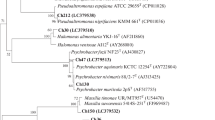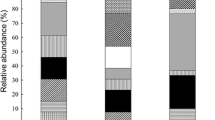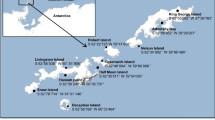Abstract
Bacteria associated with the marine macroalga Laminaria saccharina, collected from the Kiel Fjord (Baltic Sea, Germany), were isolated and tested for antimicrobial activity. From a total of 210 isolates, 103 strains inhibited the growth of at least one microorganism from the test panel including Gram-negative and Gram-positive bacteria as well as a yeast. Most common profiles were the inhibition of Bacillus subtilis only (30%), B. subtilis and Staphylococcus lentus (25%), and B. subtilis, S. lentus, and Candida albicans (11%). In summary, the antibiotic-active isolates covered 15 different activity patterns suggesting various modes of action. On the basis of 16S rRNA gene sequence similarities >99%, 45 phylotypes were defined, which were classified into 21 genera belonging to Alphaproteobacteria, Betaproteobacteria, Gammaproteobacteria, Bacteroidetes, Firmicutes, and Actinobacteria. Phylogenetic analysis of 16S rRNA gene sequences revealed that four isolates possibly represent novel species or even genera. In conclusion, L. saccharina represents a promising source for the isolation of new bacterial taxa and antimicrobially active bacteria.


Similar content being viewed by others
References
Afonso A, Hon F, Brambilla R (1999) Structure elucidation of Sch20562, a glucosidic cyclic dehydropeptide lactone-the major component of W-10 antifungal antibiotic. J Antibiot (Tokyo) 52:383–397
Baltz RH, Miao V, Wrigley SK (2005) Natural products to drugs: daptomycin and related lipopeptide antibiotics. Nat Prod Rep 22:717–741
Bartsch I, Wiencke C, Bischof K, Buchholz CM, Buck BH, Eggert A, Feuerpfeil P, Hanelt D, Jacobsen S, Karez R, Karsten U, Molis M, Roleda MY, Schubert H, Schumann R, Valentin K, Weinberger F, Wiese J (2008) The genus Laminaria sensu lato: recent insights and developments. European J Phycol 43:1–86
Berdy J (2005) Bioactive microbial metabolites. J Antibiot (Tokyo) 58:1–26
Bernan VS, Greenstein M, Carter GT (2004) Mining marine microorganisms. Curr Med Chem Anti-infective Agents 3:181–195
Bhattacharjee AK, Hartell MG, Nichols DA, Hicks RP, Stanton B, van Hamont JE, Milhous WK (2004) Structure-activity relationship study of antimalarial indolo [2,1-b]quinazoline-6,12-diones (tryptanthrins). Three dimensional pharmacophore modeling and identification of new antimalarial candidates. Eur J Med Chem 39:59–67
Brinkhoff T, Bach G, Heidorn T, Liang LF, Schlingloff A, Simon M (2004) Antibiotic production by a Roseobacter clade-affiliated species from the German Wadden Sea and its antagonistic effects on indigenous isolates. Appl Env Microbiol 70:2560–2565
Bull AT, Stach JEM (2007) Marine actinobacteria: new opportunities for natural product search and discovery. Trends Microbiol 15:491–499
Cheng XC, Jensen PR, Fenical W (1999) Arenaric acid, a new pentacyclic polyether produced by a marine bacterium (Actinomycetales). J Nat Prod 62:605–607
Collins VG, Willoughby LG (1962) The distribution of bacteria and fungal spores in Blelham Tarn with particular reference to an experimental overturn. Arch Mikrobiol 43:294–307
Corre S, Prieur D (1990) Density and morphology of epiphytic bacteria on the kelp Laminaria digitata. Botanica Marina 33:515–523
Crisley FD (1964) Antibacterial interaction between bromothymol blue and polymyxin B. Nature 203:211–213
Diggle SP, Crusz SA, Cámara M (2007) Quorum sensing. Curr Biol 17:907–910
Dimitrieva GY, Dimitriev SM (1996) Symbiotic microflora of the brown algae from the genus Laminaria as a bioindicator of the ecological state of coastal Laminaria biocoenoses. Mar Biol 22:300–305
Dimitrieva GY, Crawford RL, Yuksel GU (2006) The nature of plant growth-promoting effects of a pseudoalteromonad associated with the marine algae Laminaria japonica and linked to catalase excretion. J Appl Microbiol 100:1159–1169
Felsenstein J (1981) Evolutionary trees from DNA-sequences—a maximum-likelihood approach. J Mol Evo 17:368–376
Fenical W, Jensen PR (2006) Developing a new resource for drug discovery: marine actinomycete bacteria. Nat Chem Biol 2:666–673
Fiedler HP, Bruntner C, Bull AT, Ward AC, Goodfellow M, Potterat O, Puder C, Mihm G (2005) Marine actinomycetes as a source of novel secondary metabolites. Antonie Van Leeuwenhoek 87:37–42
Gerard J, Lloyd R, Barsby T, Haden P, Kelly MT, Andersen RJ (1997) Massetolides A-H, antimycobacterial cyclic depsipeptides produced by two pseudomonads isolated from marine habitats. J Nat Prod 60:223–229
Giovannoni S, Rappé M (2000) Evolution, diversity, and molecular ecology of marine prokaryotes. In: Kirchman DL (ed) Microbial ecology of the oceans. Wiley-Liss, New York, pp 47–84
Gonzalez JM, Moran MA (1997) Numerical dominance of a group of marine bacteria in the alpha-subclass of the class Proteobacteria in coastal seawater. Appl Env Microbio 63:4237–4242
Guindon S, Gascuel O (2003) A simple, fast, and accurate algorithm to estimate large phylogenies by maximum likelihood. Sys Biol 52:696–704
Guindon S, Lethiec F, Duroux P, Gascuel O (2005) PHYML Online—a web server for fast maximum likelihood-based phylogenetic inference. Nucleic Acid Res 33:W557–W559
Hopwood DA (2007) Therapeutic treasures from the deep. Nat Chem Biol 3:457–458
Hubbard BK, Walsh CT (2003) Vancomycin assembly: nature’s way. Angew Chem Int Ed Engl 42:730–765
Imamura N, Nishijima M, Takadera T, Adachi K, Sakai M, Sano H (1997) New anticancer antibiotics pelagiomicins, produced by a new marine bacterium Pelagiobacter variabilis. J Antibiot (Tokyo) 50:8–12
Ishihara H, Takoh M, Nishibayashi R, Sato A (2002) Distribution and variation of bacitracin synthetase gene sequences in laboratory stock strains of Bacillus licheniformis. Curr Microbiol 45:18–23
Ivanova EP, Bakunina IY, Nedashkovskaya OI, Gorshkova NM, Alexeeva YV, Zelepuga EA, Zvaygintseva TN, Nicolau DV, Mikhailov VV (2003) Ecophysiological variabilities in ectohydrolytic enzyme activities of some Pseudoalteromonas species, P. citrea, P. issachenkonii, and P. nigrifaciens. Curr Microbiol 46:6–10
Jensen PR, Mincer TJ, Williams PG, Fenical W (2005) Marine actinomycete diversity and natural product discovery. Antonie Van Leeuwenhoek 87:43–48
Kain JM (1979) A view of the genus Laminaria. Ocean Mar Biol Ann Rev 17:101–161
Kamigiri K, Tokunaga T, Shibazaki M, Setiawan B, Rantiatmodjo RM, Morioka M, Suzuki K (1996) YM-30059, a novel quinolone antibiotic produced by Arthrobacter sp. J Antibiot (Tokyo) 49:823–825
Klevens RM, Edwards JR, Tenover FC, McDonald LC, Horan T, Gaynes R (2006) National Nosocomial Infections Surveillance System. Changes in the epidemiology of methicillin-resistant Staphylococcus aureus in intensive care units in US hospitals, 1992–2003. Clin Infect Dis 42:389–391
Lam KS (2006) Discovery of novel metabolites from marine actinomycetes. Curr Opin Microbiol 9:245–251
Lane DL (1991) 16S/23S rRNA sequencing. In: Stackebrandt E, Goodfellow M (eds) Nucleic acid techniques in bacterial systematics. Wiley, New York, pp 115–175
Laycock RA (1974) Detrital food-chain based on seaweeds .1. Bacteria associated with surface of Laminaria fronds. Mar Biol 25:223–231
Longeon A, Peduzzi J, Barthelemy M, Corre S, Nicolas JL, Guyot M (2004) Purification and partial identification of novel antimicrobial protein from marine bacterium Pseudoalteromonas species strain X153. Mar Biotechnol 6:633–641
Ludwig W, Stunk O, Westram R, Richter L, Meier H, Yadhukumar, Buchner A, Lai T, Steppi S, Jobb G, Förster W, Brettske I, Gerber S, Ginhart AW, Gross O, Grumann S, Hermann S, Jost R, König A, Liss T, Lüßmann R, May M, Nonhoff B, Reichel B, Strehlow R, Stamatakis A, Stuckmann N, Vilbig A, Lenke M, Ludwig T, Bode A, Schleifer KH (2004) ARB: a software environment for sequence data. Nucleic Acid Res 32:1363–1371
Lüning K (1990) Seaweeds: their environment, biogeography, and ecophysiology. Wiley, New York
Matsumoto N, Tsuchida T, Umekita M, Kinoshita N, Iinuma H, Sawa T, Hamada M, Takeuchi T (1997) Epoxyquinomicins A, B, C and D, new antibiotics from Amycolatopsis. I. Taxonomy, fermentation, isolation and antimicrobial activities. J Antibiot (Tokyo) 50:900–905
Mazure HGF, Field JG (1980) Density and ecological importance of bacteria on kelp fronds in an upwelling region. J Exp Mar Biol Ecol 43:173–182
Michel G, Nyval-Collen P, Barbeyron T, Czjzek M, Helbert W (2006) Bioconversion of red seaweed galactans: a focus on bacterial agarases and carrageenases. Appl Microbiol Biotechnol 71:23–33
Minkwitz A, Berg G (2001) Comparison of antifungal activities and 16S ribosomal DNA sequences of clinical and environmental isolates of Stenotrophomonas maltophilia. J Clin Microbiol 39:139–145
Muscholl-Silberhorn A, Thiel V, Imhoff J (2008) Abundance and bioactivity of cultured sponge-associated bacteria from the Mediterranean Sea. Microb Ecol 55:94–106
Muyzer G, de Waal EC, Uitterlinden AG (1993) Profiling of complex microbial populations by denaturing gradient gel electrophoresis analysis of polymerase chain reaction-amplified genes coding for 16S rRNA. Appl Environ Microbiol 59:695–700
Newman DJ, Cragg GM (2006) Compounds from the ocean as drugs and drug leads. Chemistry today 24:42–47
Nold SC, Zwart G (1998) Patterns and governing forces in aquatic microbial communities. Aquat Ecol 32:17–35
Oclarit JM, Okada H, Ohta S, Kaminura K, Yamaoka Y, Iizuka T, Miyashiro S, Ikegami S (1994) Anti-bacillus substance in the marine sponge, Hyatella species, produced by an associated Vibrio species bacterium. Microbios 78:7–16
Pohlmann J, Lampe T, Shimada M, Nell PG, Pernerstorfer J, Svenstrup N, Brunner NA, Schiffer G, Freiberg C (2005) Pyrrolidinedione derivatives as antibacterial agents with a novel mode of action. Bioorg Med Chem Lett 15:1189–1192
Recktenwald J, Shawky R, Puk O, Pfennig F, Keller U, Wohlleben W, Pelzer S (2002) Nonribosomal biosynthesis of vancomycin-type antibiotics: a heptapeptide backbone and eight peptide synthetase modules. Microbiol 148:1105–1118
Rogers MJ, Cundliffe E, McCutchan TF (1998) The antibiotic micrococcin is a potent inhibitor of growth and protein synthesis in the malaria parasite. Antimicrob Agents Chemother 42:715–716
Sawabe T, Ohtsuka M, Ezura Y (1997) Novel alginate lyases from marine bacterium Alteromonas sp. strain H-4. Carb Res 304:69–76
Sawabe T, Makino H, Tatsumi M, Nakano K, Tajima K, Iqbal MM, Yumoto I, Ezura Y, Christen R (1998a) Pseudoalteromonas bacteriolytica sp. nov., a marine bacterium that is the causative agent of red spot disease of Laminaria japonica. Int J Syst Bacteriol 48:769–774
Sawabe T, Sawada C, Suzuki E, Ezura Y (1998b) Intracellular alginate-oligosaccharide degrading enzyme activity that is incapable of degrading intact sodium alginate from a marine bacterium Alteromonas sp. Fish Sci 64:320–324
Sawabe T, Tanaka R, Iqbal MM, Tajima K, Ezura Y, Ivanova EP, Christen R (2000) Assignment of Alteromonas elyakovii KMM 162T and five strains isolated from spot-wounded fronds of Laminaria japonica to Pseudoalteromonas elyakovii comb. nov. and the extended description of the species. Int J Syst Evol Microbiol 50:265–271
Skerratt JH, Bowman JP, Hallegraeff G, James S, Nichols PD (2002) Algicidal bacteria associated with blooms of a toxic dinoflagellate in a temperate Australian estuary. Mar Ecol Prog Ser 244:1–15
Staufenberger T, Thiel V, Wiese J, Imhoff JF (2008) Phylogenetic analysis of bacteria associated with Laminaria saccharina. FEMS Microbiol Ecol 64:65–77
Tatusova TA, Madden TL (1999) BLAST 2 Sequences, a new tool for comparing protein and nucleotide sequences. FEMS Microbiol Lett 174:247–250
Toledo G, Green W, Gonzalez RA, Christoffersen L, Podar M, Chang HW, Hemscheidt T, Trapido-Rosenthal HG, Short J, Bidigare RR, Mathur EJ (2006) High throughput cultivation for isolation of novel marine microorganisms. Oceanography 19:120–125
Tran H, Ficke A, Asiimwe T, Höfte M, Raaijmakers JM (2007) Role of the cyclic lipopeptide massetolide A in biological control of Phytophthora infestans and in colonization of tomato plants by Pseudomonas fluorescens. New Phytol 175:731–742
Tsuchida T, Inuma H, Kinoshita N, Ikeda T, Sawa T, Hamada M, Takeuchi T (1995) Azicemicins A and B, a new antimicrobial agent produced by Amycolatopsis. I. Taxonomy, fermentation, isolation, characterization and biological activities. J Antibiot (Tokyo) 48:217–221
Udwary DW, Zeigler L, Asolkar RN, Singan V, Lapidus A, Fenical W, Jensen PR, Moore BS (2007) Genome sequencing reveals complex secondary metabolome in the marine actinomycete Salinispora tropica. Proc Natl Acad Sci 104:10376–10381
Urvantseva A, Bakunina I, Nedashkovskaya O, Kim S, Zvyagintseva T (2006) Distribution of intracellular fucoidan hydrolases among marine bacteria of the family Flavobacteriaceae. Appl Biochem Microbiol 42:484–491
Vaidya RJ, Shah IM, Vyas PR, Chatpar HS (2001) Production of chitinase and its optimization from a novel isolate Alcaligenes xylosoxydans: potential in antifungal biocontrol. J Microbiol Biotechnol 17:691–696
Vairappan CS, Suzuki M, Motomura T, Ichimura T (2001) Pathogenic bacteria associated with lesions and thallus bleaching symptoms in the Japanese kelp Laminaria religiosa Miyabe (Laminariales, Phaeophyceae). Hydrobiologia 445:183–191
Vandamme EJ, Demain AL (1976) Nutrition of Bacillus brevis ATCC 9999, the producer of gramicidin S. Antimicrob Agents Chemother 10:265–273
Wagner-Döbler I, Rheims H, Felske A, El-Ghezal A, Flade-Schorder D, Laatsch H, Lang S, Pukall R, Tindall BJ (2004) Oceanibulbus indolifex gen. nov., sp nov., a North Sea alphaproteobacterium that produces bioactive metabolites. Int J Syst Evol Microbiol 54:1177–1184
Wang GY (2006) Diversity and biotechnological potential of the sponge-associated microbial consortia. J Ind Microbiol Biotechnol 33:545–551
Wang JX, Mou HJ, Jiang XL, Guan HS (2006) Characterization of a novel beta-agarase from marine Alteromonas sp SY37-12 and its degrading products. Appl Microbiol Biotechnol 71:833–839
Watve MG, Ticko R, Jog MM, Bhole BD (2001) How many antibiotics are produced by the genus Streptomyces? Arch Microbiol 176:386–390
Wickerham L (1951) Taxonomy of yeasts. U S Dept Techt Bull 1029:1–56
Yan LM, Boyd KG, Adams DR, Burgess JG (2003) Biofilm-specific cross-species induction of antimicrobial compounds in bacilli. Appl Environ Microbiol 69:3719–3727
Yoshikawa K, Takadera T, Adachi K, Nishijima M, Sano H (1997) Korormicin, a novel antibiotic specifically active against marine gram-negative bacteria, produced by a marine bacterium. J Antibiot 50:949–953
Zheng ZH, Zeng W, Huang YJ, Yang ZY, Li J, Cai HR, Su WJ (2000) Detection of antitumor and antimicrobial activities in marine organism associated actinomycetes isolated from the Taiwan Strait, China. FEMS Microbiol Lett 188:87–91
Acknowledgements
This study was supported by the Ministerium für Wissenschaft, Wirtschaft und Verkehr des Landes Schleswig-Holstein, Germany (project “Isolierung und Charakterisierung neuer Wirkstoffe aus Laminaria saccharina, Halichondria panicea und assoziierten Mikroorganismen” and the Kieler Wirkstoff-Zentrum am IFM-GEOMAR). We thank CRM and MariLim, both located at Kiel (Germany), for taking the L. saccharina samples. Special thanks go to Katja Kulke and Regine Wicher for technical assistance.
Author information
Authors and Affiliations
Corresponding author
Rights and permissions
About this article
Cite this article
Wiese, J., Thiel, V., Nagel, K. et al. Diversity of Antibiotic-Active Bacteria Associated with the Brown Alga Laminaria saccharina from the Baltic Sea. Mar Biotechnol 11, 287–300 (2009). https://doi.org/10.1007/s10126-008-9143-4
Received:
Accepted:
Published:
Issue Date:
DOI: https://doi.org/10.1007/s10126-008-9143-4




